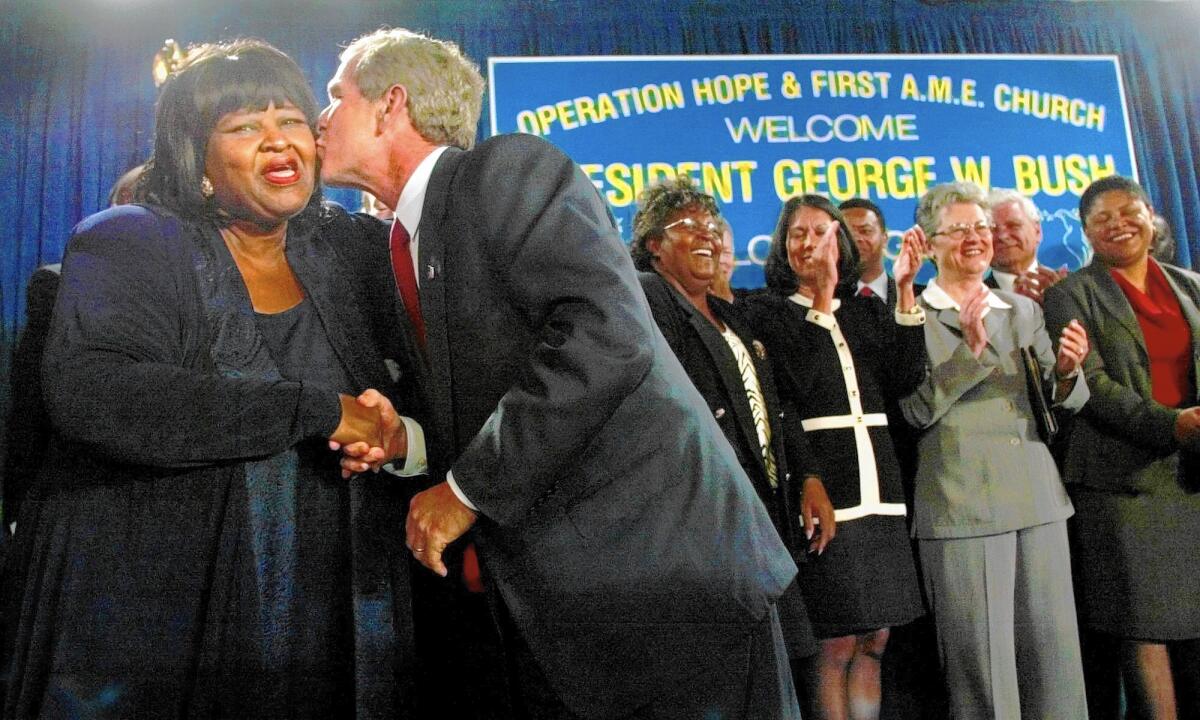Marva Smith Battle-Bey dies at 64; urban planning expert helped bring development to South L.A.

- Share via
Marva Smith Battle-Bey, an urban planning expert who worked to bring shopping centers and other development to South Los Angeles over more than three decades, died April 7.
She was 64 and had pneumonia, among other conditions, said her sister, Gloria Gilmore.
Smith Battle-Bey was at the center of efforts to rebuild damaged stretches of the city after the 1992 riots. But unlike other revitalization enthusiasts of the period, she was already there, working for redevelopment, years before the riots broke out — and would stick to the work for decades afterward.
She was still chief executive and president of the nonprofit Vermont Slauson Economic Development Corp. until a few months before she died, said her friend and colleague Lura Daniel-Ball.
Daniel-Ball said Smith Battle-Bey had “fallen in love with the city” during her days in graduate school in urban planning at USC, and she resolved to stay and work for its improvement.
Under her leadership, the nonprofit organization developed the Vermont-Slauson Shopping Center in 1981. The complex on the south side of Slauson Avenue is home to Kmart, CVS and other retailers. She also led the organization’s development of two affordable housing projects and its creation of the Business Enterprise Center, at 6109 S. Western Ave.
“Marva’s philosophy was ‘get it done,’” Daniel-Ball said. Through the ups and downs of state and federal support — and despite the difficulty of securing private investment — Smith Battle-Bey kept up her efforts. When she met with roadblocks, “‘No’ was not the answer,” Daniel-Ball said. “It was, ‘We need to find another way.’”
Asked by The Times in 2007 how she dealt with disappointment, she replied: “You get over that stuff because you have to.”
Hundreds of buildings were burned or damaged along the Vermont Avenue corridor in the 1992 riots. Afterward, with the area still in the national limelight, civic and commercial leaders talked in bold terms about bringing in badly needed grocery stores and other investments.
Millions in revitalization funds were said to have been promised. Companies, corporate foundations and philanthropic groups flocked to the rebuilding effort at first.
But two years later, a Times report said that half of the more than 600 destroyed properties along the corridor remained empty, most of them clustered south of the 10 Freeway. As the years passed, hopes for a massive private investment faded in what was then called South-Central L.A., and the grocery-store ambitions fell short.
Five years after the riots, Smith Battle-Bey gave her assessment of the challenge. She used terms far more tempered than the ones that had been uttered by other redevelopment boosters in the heady early days of rebuilding efforts. It would take 10 years just to restore the area to its pre-riot condition, she cautioned.
In 2003, she led efforts to develop a property across the street from the Vermont-Slauson Shopping Center into a Gigante grocery store, which is now an El Super.
She was born Marva Jo Smith in Detroit on June 18, 1951, to Serdie and Thelma Smith. Her father was an autoworker from Mississippi. She graduated from high school at 16 and received a scholarship to Michigan State, where she earned a degree in urban planning, said her sister, who described her as quiet and patient. “She never rushed,” she said.
Seeking warmer weather, she enrolled as a graduate student at USC, where she studied urban planning and public administration. She also earned a PhD in urban studies at the school. She married Stephon F. Battle-Bey, and although they did not remain married, they remained a couple; he was her companion to the end, her sister said.
Smith Battle-Bey founded the economic development organization in 1979 while working for Los Angeles Mayor Tom Bradley. The effort was a response to concerns over the closure of a Sears store.
Over the years, besides development projects, the nonprofit worked to help connect small businesses to loans, train entrepreneurs and renovate scores of homes for elderly residents.
Experience made Smith Battle-Bey realistic about the difficulties of redeveloping urban neighborhoods and rallying residents of this fragmented metropolis. The 1981 Vermont-Slauson development was the “first major retail investment here since the 1965 riots,” she pointed out to The Times.
But she also never gave up advocating for investment in the area. “People have the right to an opportunity to work, have the right to contribute back to society, have the right to a safe home. But you can’t have these things if people aren’t gainfully employed,” she told The Times in 1997.
“She was always optimistic,” said Pam Bizzell, project manager with the organization. “Just a fearless leader.”
Besides Stephon Battle-Bey and her sister, Smith Battle-Bey is survived by brothers Doward Smith and Troy Rials.
More to Read
Start your day right
Sign up for Essential California for the L.A. Times biggest news, features and recommendations in your inbox six days a week.
You may occasionally receive promotional content from the Los Angeles Times.






